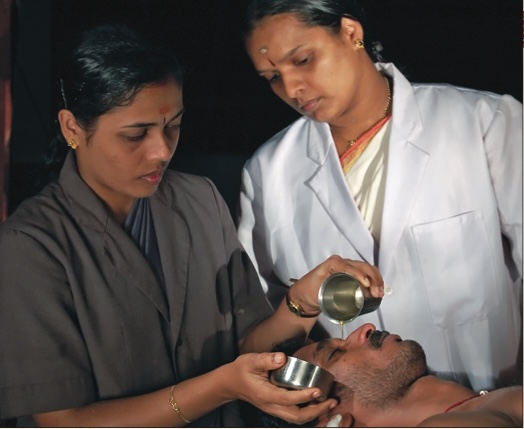BY VRINDAVANAM S. GOPALAKRISHNAN
From all over india and far beyond her borders, people come to Sreedhareeyam Ayurvedic Eye Hospital and Research Center in Kerala. Many come to cure ailments unhealed by modern medicine, such as rheumatoid arthritis. But this hospital, set in the village of Kizhkombu, near the city of Kochi, is best known for treating diseases of the eye.
Dr. N. P. P. Namboothiri is the managing director and chief medical officer of Sreedhareeyam. He has also served for three decades as the chief medical officer of the Kerala government’s state-owned ayurvedic hospital. His family, owners of a precious collection of old medical manuscripts inscribed on ola leaves, have for four generations been ayurvedic physicians specializing in treating eye disease.
The research-oriented approach of the present generation of the physicians, combined with the availability of modern facilities, has culminated in the birth of this well-equipped 500-bed eye hospital, which treats 200 to 300 patients daily. The rural setting, overlooking a lush green expanse of paddy fields, provides the clean and serene atmosphere required for convalescence. The hospital maintains its own cow and goat dairy, as well as a large garden to grow rare species of medicinal plants and other required herbs. It is equipped with modern diagnostic tools, and maintains six private cottages for the convenience of patients. All medicines and formulations used in eye treatment are manufactured in their own certified factory under the supervision of Dr. Namboothiri according to the traditional formulas.
“We could provide this with the grace of our family Deity, Bhadrakali, ” says Dr. Namboothiri.
For Mr. N. P. Narayanan Namboothiri, chairman of Sreedhareeyam, it is not medicine alone that cures disease. Divine intervention should always be sought. Therefore, all the drugs manufactured are taken to the Deity at the temple in the hospital complex to be blessed by the Goddess. When treatment is begun, the patient is brought to the entrance of the traditional home, where the first dose of medicine is administered in front of the sacred lamp after offering prayers. Patients participate in this tradition regardless of their different religious beliefs.
Many eye diseases are treated here, including retinitis pigmentosa caused by diabetes. This disease is most often seen in children born from blood-related parents, and Western allopathic medicine offers no treatment for it. Other conditions treated here include macular degeneration, glaucoma, cataract and detached retina. Each is approached with a customized regimen of ayurvedic medicines, eye exercises and diet.
Attributing the ever-increasing incidence of eye ailments among children to the fast life, fast food and continuous viewing of television, Dr. N. P. P. Namboothiri said that absence of eye exercise is a major reason for some of the ailments. He states that eye exercise is of paramount importance, pointing out that skilled practitioners of Bharatanatyam and other traditional dance forms, with their intense patterns of eye movement, have the lowest incidence of eye diseases.
The ancient ayurvedic scriptures describe the treatment of many illnesses for which “modern ” medicine has found no remedies, such as retinitis pigmentosa. The Shalakya Tantra, for instance, contains descriptions of some 76 eye diseases, 28 ear diseases and 31 nose diseases.
Dr. Namboothiri told Hinduism Today, “Urdhwanga Chikita, or Shalakya Tantra, is one of the eight branches of ayurveda. It offers a detailed study of the etiology, diagnosis, prognosis, prevention and treatment of diseases affecting the organs in the head and neck–the ears, nose, eyes, throat, etc. Of the three main classic texts of ayurveda, Susrutha Samhitha provides the most profound knowledge on this branch of treatment. Acharya Susrutha was the greatest proponent of this science. He could be hailed as the pioneer surgeon in medical history who systematically and elaborately dealt with the anatomical structure of the eye. The prognoses made by him on aveitis and glaucoma are regarded as exceptional.”
Dr. Sharat Menon, a professor from Texas, USA, who has undergone treatment at Sreedhareeyam, told Hinduism Today that based on his experience with other such institutions in recent years, Sreedhareeyam is unparalleled in the ayurvedic treatment of eye ailments.
Another enthusiastic Sreedhareeyam patient is Dr. James Lunney, an experienced physician from Canada. He says, “ayurveda is the ancient medical system of India which encompasses the healing of body, mind and spirit.” This is accomplished through diet, lifestyle and rejuvenation, along with the use of cleansing programs and medicinal herbs. Instead of focusing narrowly on the patient’s current disorder, ayurvedic medicine targets the root cause of disease–not only treating the disorder itself but also eliminating problems before they arise.
See http:/www.sreedhareeyam.com [http:/www.sreedhareeyam.com]


